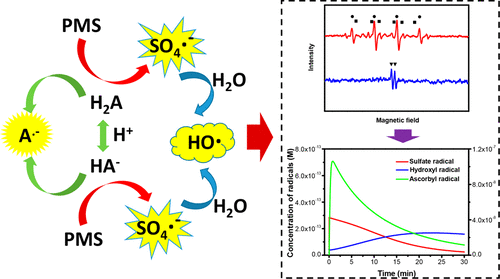当前位置:
X-MOL 学术
›
Environ. Sci. Technol.
›
论文详情
Our official English website, www.x-mol.net, welcomes your
feedback! (Note: you will need to create a separate account there.)
Oxidation of Microcystin-LR via Activation of Peroxymonosulfate Using Ascorbic Acid: Kinetic Modeling and Toxicity Assessment
Environmental Science & Technology ( IF 10.8 ) Pub Date : 2018-03-14 00:00:00 , DOI: 10.1021/acs.est.7b06560 Shiqing Zhou 1, 2 , Yanghai Yu 1 , Weiqiu Zhang 2 , Xiaoyang Meng 2 , Jinming Luo 2 , Lin Deng 1, 2 , Zhou Shi 1 , John Crittenden 2
Environmental Science & Technology ( IF 10.8 ) Pub Date : 2018-03-14 00:00:00 , DOI: 10.1021/acs.est.7b06560 Shiqing Zhou 1, 2 , Yanghai Yu 1 , Weiqiu Zhang 2 , Xiaoyang Meng 2 , Jinming Luo 2 , Lin Deng 1, 2 , Zhou Shi 1 , John Crittenden 2
Affiliation

|
Advanced oxidation processes (AOPs) have been widely used for the destruction of organic contaminants in the aqueous phase. In this study, we introduce an AOP on activated peroxymonosulfate (PMS) by using ascorbic acid (H2A) to generate sulfate radicals (SO4•–). Sulfate radicals, hydroxyl radicals (HO•), and ascorbyl radicals (A•–) were found using electron spin resonance (ESR). But we found A•– is negligible in the degradation of microcystin-LR (MCLR) due to its low reactivity. We developed a first-principles kinetic model to simulate the MCLR degradation and predict the radical concentrations. The MCLR degradation rate decreased with increasing pH. The scavenging effect of natural organic matter (NOM) on SO4•– was relatively small compared to that for HO•. Considering both energy consumption and MCLR removal, the optimal H2A and PMS doses for H2A/PMS process were determined at 1.0 × 10–6 M and 1.6 × 10–5 M, respectively. In addition, we determined the toxicity using the protein phosphatase 2A (PP2A) test and the results showed that MCLR was readily detoxified and its oxidation byproducts were not hepatotoxic. Overall, our work provides a new type of AOP and a promising, efficient, and environmental-friendly method for removing microcystins in algae-laden water.
中文翻译:

微囊藻毒素-LR通过抗坏血酸活化过氧单硫酸盐的氧化:动力学模型和毒性评估。
先进的氧化工艺(AOP)已被广泛用于破坏水相中的有机污染物。在这项研究中,我们通过使用抗坏血酸(H 2 A)生成硫酸根(SO 4 •–)在活化的过氧单硫酸盐(PMS)上引入AOP 。使用电子自旋共振(ESR)发现了硫酸根,羟基(HO •)和抗坏血酸基(A •–)。但是我们发现•由于微囊藻毒素-LR(MCLR)的低反应性,其降解可忽略不计。我们开发了第一原理动力学模型来模拟MCLR降解并预测自由基浓度。随着pH值的增加,MCLR降解速率降低。与HO •相比,天然有机物(NOM)对SO 4 •的清除作用相对较小。同时考虑能耗和去除MCLR,确定H 2 A / PMS工艺的最佳H 2 A和PMS剂量为1.0×10 –6 M和1.6×10 –5M分别。此外,我们使用蛋白磷酸酶2A(PP2A)测试确定了毒性,结果表明MCLR易于解毒,其氧化副产物无肝毒性。总的来说,我们的工作提供了一种新型的AOP,以及一种有希望,高效且环保的方法,可去除藻类水中的微囊藻毒素。
更新日期:2018-03-14
中文翻译:

微囊藻毒素-LR通过抗坏血酸活化过氧单硫酸盐的氧化:动力学模型和毒性评估。
先进的氧化工艺(AOP)已被广泛用于破坏水相中的有机污染物。在这项研究中,我们通过使用抗坏血酸(H 2 A)生成硫酸根(SO 4 •–)在活化的过氧单硫酸盐(PMS)上引入AOP 。使用电子自旋共振(ESR)发现了硫酸根,羟基(HO •)和抗坏血酸基(A •–)。但是我们发现•由于微囊藻毒素-LR(MCLR)的低反应性,其降解可忽略不计。我们开发了第一原理动力学模型来模拟MCLR降解并预测自由基浓度。随着pH值的增加,MCLR降解速率降低。与HO •相比,天然有机物(NOM)对SO 4 •的清除作用相对较小。同时考虑能耗和去除MCLR,确定H 2 A / PMS工艺的最佳H 2 A和PMS剂量为1.0×10 –6 M和1.6×10 –5M分别。此外,我们使用蛋白磷酸酶2A(PP2A)测试确定了毒性,结果表明MCLR易于解毒,其氧化副产物无肝毒性。总的来说,我们的工作提供了一种新型的AOP,以及一种有希望,高效且环保的方法,可去除藻类水中的微囊藻毒素。











































 京公网安备 11010802027423号
京公网安备 11010802027423号